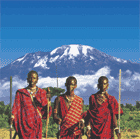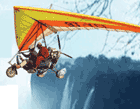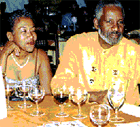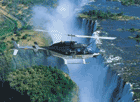|
|
|
|
|
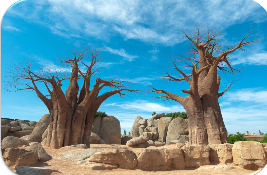
Size : 590 000 km˛
Climate : Tropical. One hot humid season (October to April). One
cool dry season (May to November).
Population : 17 million
Roads : 120 000 km
Religions : Christian, Muslim
Official Languages : Malagasy, French and English
The best time to visit Madagascar is from May to December, when
you can take advantage of the lower temperatures and sunniest
weather.
Madagascar has evolved into one of the world's most phenomenal
destinations for natural history travel. The world's
fourth-largest island contains an immense diversity flora and
fauna Of 12,000 plant species identified here, 10,000 are
endemic to the island including seven of the world's nine
species of the iconic Baobab tree, some Renowned national parks
and World Heritage Site. Madagascar travel takes you through
diverse habitats from 5.000 km of coastal line, 220 small
islands to Bio-diversity hot spot. We seek out some of the 40
different species of lemurs, a primate group found only on
Madagascar, and identify many species of chameleons in their
wild habitat as well as some of the world's most bizarre
creatures on Earth like the nightmarish hissing cockroach,
so-called Dracula ants, and the Giraffe-necked weevil. Rich and
fascinating culture, heritage today is composed of 18 different
ethnic groups that derive from a long history of trade and
migration from throughout Indonesia, Africa and the Arabian
Peninsula, all united today in a common Malagasy culture and
language. Legendary hospitality of the Malagasy population.
Madagascar have a lot of precious stones as well.

Nosy Be
These tropical islands off the northwest coast have some of the
region's finest beaches. Most accessible on Nosy Be is Andilana,
the northernmost beach. Don't miss the day trip to beautiful,
reef-ringed Nosy Tanikely, a marine reserve with a lovely, sunny
beach. Nosy Komba has a good, small beach near Ampangorinana
village. There are real gems further afield on Nosy Iranja (the
'turtles' island) and in the Mitsio Isles.
Ile Ste-Marie
Along the west coast, there are a number of secluded, palm-lined
coves, off which to swim and snorkel and there is a stunning
beach on the offshore islet of Ile Aux Nattes. The orchids are
at their peak in September and the whales' migration takes place
between July and October. . Its dense vegetation and the
difficulty of navigating the lagoons which surround it made it
an ideal base for pirates and, later, a colony for convicts.
There are several historic sites, including Madagascar's oldest
Catholic church (1837). The island is also known for its
beautiful white-sand beaches and coral reefs.
Ifaty and Nosy Ve
Ifaty has a pleasant beach and easy access to the spiny desert.
The coral reefs attract scuba divers and there is an excellent
PADI diving centre. The offshore islet of Nosy Ve is a terrific
place for snorkelling and most people enjoy spending the day on
a tiny desert isle. Another attraction is the graceful tropic
birds who breed on Nosy Ve.
Morondava
The Morondava seafront has a wide, white sandy beach off which
it is safe to swim
Madagascar endemic Flora
Madagascar is legendary for its profusion
of wildlife and flora, 80% of which is found nowhere
else on earth.
-10 families and 260 genera of plants are
endemic to Madagascar. Only Australia (with 13) has more
endemic species of plants.
-165 of Madagascar's 170 palms are not
found anywhere else. For comparison, mainland Africa has
less than 60 species of palm
-Of the 8 species of baobab found in the
world, six are endemic to Madagascar
-An entire family of plants, the
Didiereaceae is unique to Madagascar. Didiereaceae
plants are found in the arid southwest and closely
resemble some forms of cacti. Unlike catci though, they
produce small deciduous leaves which are protected by
meanacing thorns and spines that grow directly out of
the plant's many branches.
-95% of the species found in the Spiny
desert exist only in this habitat unique to Madagascar.
-Madagascar has nearly 1000 known species
of orchids, of which 85% are endemic.
-Anti-cancer drugs (vincristine,
vinblastine) derived from the Madagascar rosy periwinkle
generated over a billion dollars in revenue for Eli
Lilly & Co.
Madagascar endemic Wildlife
Madagascar - an isolated island about
twice the size of Arizona - has some of the highest
biodiversity on the planet. Of roughly 200,000 known
species found on Madagascar, about 150,000 are
endemic-meaning they exist nowhere else. Unique to the
island are more than 50 types of lemurs, 99 percent of
its frog species, and 36 genera of birds. Madgascar
houses 100 percent of the world's lemurs, half of its
chameleon species, 6 percent of its frogs, and none of
its toads
Isolated from the continents 160 million
years ago, Madagascar followed a unique evolutionary
path into enormous tortoises, elephant birds, and
lemurs. Lemurs were the highest primate form on the
island until the Malagasy people, of Afro-Polynesian
ancestry, arrived a mere 2000 years ago.
Scuba Diving
The best diving opportunities are around the islands and
islets surrounding Nosy Be on the north and west coasts.
Main diving centres are Nosy Be with its neighbouring
islands Tanikely, Nosy Mitsio and Nosy Radama, Nosy
Lava,
The island of Ste Marie, off the east coast, is
Madagascar's third scuba diving venue, of interest to
wreck divers. Coral formations are at their best around
the small island Ile Aux Nattes, to the south of Ste
Marie, and include: The Pagodas, an accessible, large
coral formation (to 12m) with rays, lobster, tortoise
and the range of coral species; Off La Crique, Coco Bay
(to 25m) has a variety of coral formations, pelagic fish
and tortoises. Paroi des Merous (to 40m) , a site for
experienced divers only, offers some exciting diving.
Further north, around La Cocoteraie, Anivorano Rocks
offers diving on granitic rocks with barracuda, (to
20m); the wreck of a fishing boat is an easy dive (15m)
providing magnificent photo opportunities; and Pointe
Alebrand (to 20m) is a beautiful dive, a sandy bed with
granite boulders, grey shark, rays, barracuda. Humpback
whales migrate past the island from July to October.
There are also some good diving sites in the south of
the island and dive operators operating there, mainly
around Ifaty Toliara and Morondava.
Surfing
The southwest is Madagascar's surfing wonderland. Many
high-quality breaks can be found among the area's coral
reefs. Given the orientation of the coast, and the
direction of the prevailing swells, the best of these
breaks tend to be lefts, although rights are also
present
they have one world-class left, one almost as good, two
other lefts, a right, and a peak - all within relatively
short boating distances of one another. And you do need
a boat to get to these places, most of which are between
one and three kilometres offshore.
With hundreds of kilometres of reefs, bays and points
stretching up the Mozambique Channel, the southwest also
holds the real possibility of many more surfing
discoveries.
South of Itampolo the coast swings east, increasing the
exposure to the swells, and to the winds. The water is
still warm and corals still grow, but the fringing reefs
begin to break apart, opening the way for inshore
setups. Rock shelves and beach breaks start to
predominate, all easily accessible from shore.
Lavanono there is one recognised left point break as
well as dozens of other unnamed reefs, including many
with real potential to turn it on in big swells.
Heading north from Fort Dauphin much of Madagascar's
East Coast could be described as a featureless wave
desert. Long straight beaches tend only to be
interrupted by river-mouths.
North from Ambila-Lemaitso the coast gets more
interesting and the opportunities increase. Coral atolls
and reefs become more common-place, and the coastline
starts to be broken up with points and bays. There could
be dozens of quality waves along this largely unexplored
stretch.
Trekking - Hiking - Climbing
Plenty of itineraries; you will be the one to choose
once on the spot. They have a full range of hikes, treks
that will allow you to discover this magnificent region
of Madagascar : Andringitra. you will discover new
landscapes: tropical humid or dry forest, savannah, palm
trees.
Conquer Cameleon and the famous Pic Boby, enter the
corridors of Tsaranoro among the huge blocks and a
luxurious vegetation, or ascend the vertiginous ridge of
the Lemur Wal
Antananarivo
Antananarivo, often abbreviated to Tana, has a
distinctively French flavor and atmosphere: French is
widely spoken, and road as well as shop signs are mostly
in French. The city is built on three levels. Dominating
the city is the Queen's Palace and associated Royal
Village or Rova Palace of Justice; Palace of
Andafiavaratra . Now a national monument, it was once
the residency of the Merina Dynasty which, in the 19th
century, united all Madagascar for the first time. On
the lowest level is the market of Analakely. The
Tsimbazaza Zoological and Botanical Garden is open
Thursday, Sunday and holidays 0800-1100 and 1400-1700.
National Parks
Spread across 152,000 hectares, the Tsingy de Bemaraha
Strict Nature Reserve is located 60 to 80km inland from
the west coast in the northern sector of the Anstingy
region of the Bemaraha Plateau, north of the Manambolo
River Gorge. Undisturbed forests, lakes and mangrove
swamps are home to a variety of rare and endangered
birds and lemurs. Rocky landscapes and limestone uplands
are cut into large peaks with a mass of limestone
needles. Rivers flow on the plateau and springs arise on
each flank of the Tsingy, making this an important water
catchment area. Ancient cemeteries can also be found in
the Gorge.
MADAGASCAR PLANS TO ATTRACT 1M VISITORS BY 2020
15.09.2014
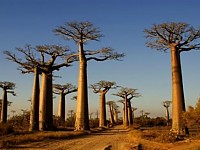
After years of turmoil
Madagascar has finally found political stability and the
Ministry of Tourism announced a plan to attract 1
million tourists by 2020. In order to achieve the goal
minister Ramarcel Benjamina Ramanantsoa has launched a
project that includes a number of measures to prepare
the island to accommodate this massive number of
arrivals. The
plan includes $10 million investment in establishments
that are safe, have attractive environment for business
infrastructure and development.The government has
launched an offer for major international hotel chains
to make investments particularly intended to attract
high-end tourism.
The promotion focuses on
other Indian Ocean islands including Comoros, Mauritius,
Seychelles, La Reunion and Mayotte.
The Royal Beach project is
one of the examples that involved national and
international investors and has received the support
from the new government. Promotion of the destination is
one of the main aims of the Government tourism
development plan. Minister has suggested increasing the
available budget to USD 300,000.
The promotion involves a
diversification of tourist attractions with an
enhancement of ethnographic and cultural attractions of
the country. The authorities also invest in training to
ensure a high level of hospitality services to the
visitors.
Madagascar seeks to leverage its traditional resources,
nature and unique ecotourism at the pristine beaches.
Minister Ramanantsoa said: “We will put the emphasis on
cultural tourism, starting from the rural destinations,
creating ‘cultural villages’ and involving local
population.” The first two 'villages' will be created in
Sainte-Marie and Nosy Be island, north of Madagascar,
which is very well known as a tourist destination among
Italians.
According to the minister, the involvement of locals in
the project of 'cultural villages' should, increase the
safety of tourists. The local population will be at the
forefront in protecting tourists because it will become
a serious source of income.
The ministry launched the
promotion of twenty-one national parks and reserves
which will be given concessions for investors.
Madagascar has also started the creation of training
centers to increase the level of services to the
international standards.
The minister is also
planning to diversify the offers on the island.
Madagascar is unique because of the diversity of species
on the island and beaches, but these two offers are not
sufficient to enhance the 'entire territory. The country
has opened a new front by joining the International
Surfing Association, which represents top destinations
for surfing. Such a move brought good response both from
private investors and traditional tourist markets such
as Australia.
By consulate General of Madagascar
Jul 24, 2013
A MODEL FOR SUSTAINABLE TOURISM: L'HEURE
BLEUE IN MADAGASCAR
(Forimmediaterelease.net)
LOS ANGELES, California - L’Heure Bleue, the eco-chic resort of
Nosy Be, in Madagascar, has been created as a model for
sustainable tourism: Everything is designed from the outset, in
a spirit of respect for the environment and sustainable
development, in harmony with local people. This property offers
true luxury – high quality services in a rare and lasting
environment. L’Heure Bleue was recently awarded Green Globe
certification.
“L’Heure Bleue wants to demonstrate that another type of
tourism is achievable, based on ethical values and respect,”
said Yves Benouaich, General Manager. “We would like to
prove that responsible tourism brings together pleasure and
well-being, without impacting on the quality of services and
benefits. We are committed to fight against global warming
and replant forests with the iconic tree of Madagascar, the
ravinala tree. For each traveler visiting L’Heure Bleue, we
plant a tree. Ravinala leaves are used to construct
traditional roofs in the area of Nosy Be. Our achievement
with Green Globe is a wonderful recognition of all our
efforts, and we are proud to be placed among our most
respected colleagues in the industry.”
Contact: Yves Benouaich, General Manager, L’Heure Bleue,
Madirokely Plage, BP 372 – Hellville, 207 – Nosy Be, Madagascar,
Tel. (261) 20 86 06 020, Fax (261) 20 86 93 275, E-mailyves.benouaich@gmail.com , www.heurebleue.com
MADAGASCAR TOURISM VANILLA ISLANDS
INTERNATIONAL TOURISM FAIR MADAGASCAR 2013 A RESOUNDING SUCCESS
June 1, 2013
The second edition of the International Tourism Fair Madagascar
2013 opened in fanfare on 29th May at the Carlton Hotel in
Antananarivo. The regional trade fair which is now earmarked as
an annual Vanilla Islands event hosted by the sister island of
Madagascar, is a showcase for the tourism attributes of all the
six island member states. The colourful opening ceremony had
several keynote speakers taking the podium to highlight the
importance and raison d'ętre of the Vanilla Islands organisation.
Mr. Eric Koller the Chairman of the Madagascar Tourism
Board welcomed the over 400 invited guests, calling on
all actors of the country's tourism industry to rally
behind the Vanilla Islands banner to further promote
Madagascar and increase its visibility worldwide.
Mr. Didier Robert, the President of the Regional Council
for Reunion Island then addressed the audience with a
strong message of unity and the need for all member
states to work together to further the aims of the
organisation and to rally behind each member start to
show solidarity and support. He proposed that the
Vanilla Islands takes on the challenge of increasing
visibility on key markets and adopt a charter to further
the credentials of the islands' biodiversity and
sustainable tourism practices.
The President of the Vanilla Islands, Seychelles
Minister for Tourism & Culture Alain St.Ange took to the
podium highlighting the organisation's progress during
his first year's mandate. He also pointed out the
challenges ahead namely better air access and the need
for tenacity amongst its member states. He alluded that
the tourism industry is a complex one and that the
rewards of hard work and determination are reaped
further down the line. He cited the example of
Seychelles which is now benefiting from double digit
growth in arrival numbers for 3 consecutive years whilst
other member states were having difficulty to sustain
growth. He went on to stress the importance of all the
islands working together and supporting each other to
further promote all events and activities of each member
state. He thanked everyone present for showing
solidarity with Madagascar and strengthening their
support for the Vanilla Islands Organisation.
Malagasy Minister Jean-Max Rakotomamonjy then addressed
the audience putting emphasis on the fact that the
country needs to better understand the tourism industry.
He stressed that government needs to provide the private
sector with the right enabling environment to allow it
to flourish and take its rightful place within the
Madagascar economy.
These keynote speeches were delivered in the presence of
Ministers, ambassadors, dignitaries, VIPs, tour
operators, travel agents and an important contingent of
audio, visual and written press.
The distinguished guests were then ushered to the
hotel's mezzanine to assist the ribbon cutting ceremony
which kicked off the official opening of the trade fair.
Next weekend will see the second edition of the
Madagascar International Tourism Fair take place in
the island's capital of Antananarivo which has
already since its inception received the full
support of other Vanilla Island partners as a key
event on the annual calendar of mutually promoted
activities to promote tourism to the islands.
"Showground: will be the Hoel Carlton in the
capital, where a significantly higher number of
attendees are expected this year. Madagascar is in
fact hoping to make this fair the Indian ocean
Tourism Fair of the Vanilla Islands regional body.
Madagascar has been enjoying increased interest
again and the island's tours industry is hoping that
this event, combined with other high profile
activities like the co-hosting of the Seychelles"
Carnival International de Victoria will spur a
revival for the sector. Madagascar had been hit hard
by the fallout of political unrest in recent years,
boycott calls and the suspension from the African
Union while the
many attractions the island has to offer were
largely laying idle.
The Vanilla Island of Mauritius, La Reunion, the
Seychelles, Comoros, and Madagascar will all be
present in a show solidarity and to showcase their
very own attractions to the press and tour operators
present. Alain St.Ange, the Seychelles Minister of
Tourism and Culture and current President of the
Indian Vanilla Islands Regional Organization and
Didier Robert the President de la region La Reunion,
the Organization's Secretary will both be leading
their respective Tourism Board's delegation to this
Madagascar tourism event. also expected is Pascal
Viroleau, the CEO the Vanilla Islands and Derek Savy,
who is set to be working with Pascal Viroleau as
soon as necessary funds are unblocked. A Vanilla
Islands meeting will also be held during this
International Tourism Fair in Madagascar. For more
information visit
http://www.madagascar-tourisme.com/en

|
|


